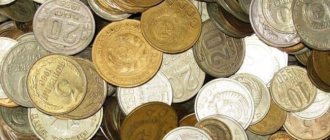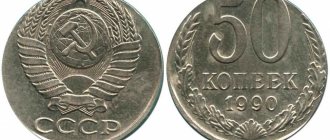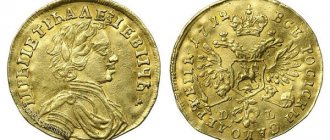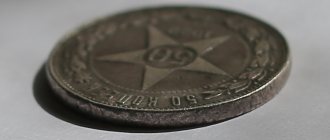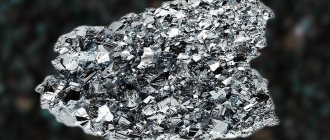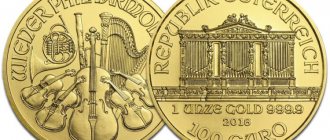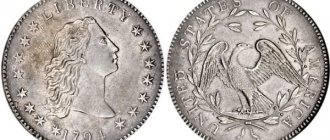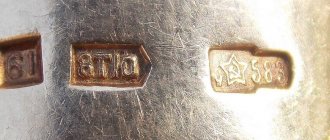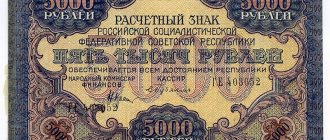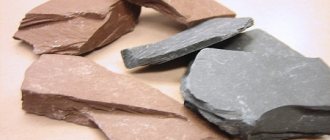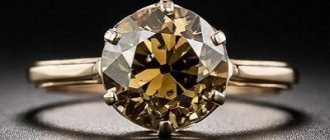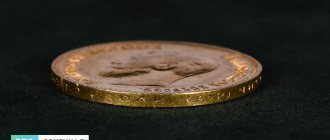History of issue and characteristics of the coin from 1921 to 1991 Circulating coins of 50 kopecks of the USSR and the RSFSR Commemorative Soviet coins of 50 kopecks Trial coins of 50 kopecks
- Trial 50 kopecks 1922
- Trial fifty dollars 1924-1927.
- Unique 50 kopeck test coin of 1929
- Trial 50 kopecks 1936 and 1941
- Trial 50 kopecks 1953, 1956, 1958 and 1959
- Trial 50 kopecks 1962, 1963 and 1967
Defective coins Cash surrogates Rare and expensive 50-kopeck coins
- Silver coin 50 kopecks (one fifty dollars) 1924
- Silver coins 50 kopecks (one fifty kopecks) 1921, 1922, 1925, 1926, 1927
- Coin 50 kopecks 1958
How much is 50 kopecks worth in the USSR? Methods for determining the price Where to buy coins of 50 kopecks USSR Coins with a face value of 50 kopecks (fifty dollars) from the times of the RSFSR and the USSR have an interesting history. In this article we will briefly outline the main production stages of their minting, consider circulating, anniversary, trial, rare and expensive coins of this denomination. We will also look at ways to determine their price, options for buying or selling, and give examples of departures from famous auctions.
History of issue and characteristics of the coin from 1921 to 1991
After the overthrow of the monarchy during the revolutionary years, the new state needed to mint its own money. However, this task was not an easy one, since the mints fell into disrepair and lost a significant part of their equipment. Although the new government wanted to uproot everything that was reminiscent of tsarist times, there was no time to develop radically new stamps. Moreover, armed conflicts continued in certain regions of the country. Therefore, in 1921, stamps were prepared based on the previous coins. The 50 kopeck coin has approximately the same characteristics as a coin of the same denomination under Nicholas II. Its diameter is almost 27 mm, its weight is 10 g, and it itself is made of 900 sterling silver.
The design of the coin has changed in the sense that instead of the attributes of royal power, symbols of workers, peasants and fertility appear on it. However, the first copies have a noticeable resemblance to the royal coins in design: the same crossed oak and laurel branches, denomination and date markings on the reverse and dots in a circle are visible here. However, the 1922 coin depicts the coat of arms of the RSFSR with a hammer and sickle and the legendary inscription: “Workers of all countries, unite!”
The edge inscription from Tsarist times also remains: “PURE SILVER 2 ZOLOTNIK 10.5 LOVES” with some difference. Due to innovations in the Russian language, they now began to write “clean” instead of the word “pure”, and also continued the tradition of minting the initials of mintsmeisters. The first period of issue of the 50 kopeck coin lasted from 1921 to 1927. In 1921, the mintmaster of the mint in Petrograd, which issued fifty dollars, was Arthur Hartmann, which is why the initials AG are on the coins of this period. But from 1922 to 1927 he was replaced by Pyotr Latyshev, and the letters PL appeared on the coins.
The design and characteristics of the 50 kopeck coin have changed several times throughout the entire Soviet history of production. For example, in 1924, on this coin the star was replaced by a composition with the central figure of a blacksmith, and instead of the inscription RSFSR, the USSR and the Soviet coat of arms appeared. After 1927, until 1961, the coin was not issued en masse, although in different years attempts were made to create test copies from different metals.
They resumed production of the 50 kopeck coin in 1961 and continued until 1991, when the Soviet Union ceased to exist. The reason for the return to fifty dollars was the reform of 1961, which involved a tenfold change in prices (1 new ruble for 10 old ones). At the same time, the new coin was radically different from the 50 kopecks of the 1920s in its characteristics. Instead of silver, they began to mint it from a complex alloy of copper, nickel and zinc. The weight of the coin decreased from 10 to 4.4 g, the diameter also decreased to 24 mm and the thickness decreased to 1.7 mm (versus the previous 27 mm and 2 mm). The metal ratio of the new coins has been discussed several times. They even tried to make them from bronze, but production was considered unprofitable. As a result, the alloy mentioned above turned out to be very wear-resistant. The new 50 kopecks now had a lighter shade and did not darken when oxidized, but acquired a greenish tint.
Circulating coins of 50 kopecks of the USSR and RSFSR
Circulating 50-kopeck coins with a denomination of 50 kopecks and one fifty-kopeck coins were issued in two main periods. They were minted in 1921-1927. and in 1961-1991. Both periods were associated with monetary reforms carried out for different reasons (see section “History of issue ...”). In this regard, the characteristics of the coins differed, including sizes, base metal and design. From a silver coin of 900 standard with details of royal coins, they gradually moved to coins made of nickel silver (an alloy of copper, nickel and zinc) with the Soviet coat of arms. At the same time, the coin became smaller in size and half as light as its royal predecessor.
Ordinary circulating coins are not of great value, with the exception of certain varieties. We will talk about which catalogs to determine them from in the section on cost. Also below you will find a section about rare and expensive coins of this denomination.
A Brief History of the Modern Fifty Dollar
Despite the length of the procession through the wallets of the Russian people, the 50-kopeck coin was not issued for 37 years (from 1926 to 1970), not counting small-circulation trial issues. Due to the separation of the Soviet republics and the subsequent crisis, penny denominations completely depreciated and practically went out of circulation.
However, the monetary reform of 1997 again returned the fifty-kopeck coins to circulation... however, the coin turned somewhat yellow, since it began to be made of brass, and also lost weight - after all, the Soviet half-ruble weighed 4.4 grams, and the perestroika ones - only 2.9 grams. But compared to the miniature fifty-kopeck piece of 1991, which weighed only 2.2 grams, the 50 kopecks of 1997 added 0.7 grams.
Soviet anniversary coins 50 kopecks
On October 1, 1967, a commemorative series of coins of the State Bank of the USSR was issued in honor of the fiftieth anniversary of Soviet power. This year, for the memorable anniversary of the 1917 revolution, among other coins, 50 million 50-kopeck copies were issued. The obverse of the commemorative coin features V.I. Lenin against the background of the hammer and sickle of a five-pointed star and the inscription USSR. On the reverse, in addition to the denomination, the inscription appeared: “fifty years of Soviet power.” Since this coin was issued in large quantities and was in circulation, it is not of particular value today and costs about 40-200 rubles, depending on the degree of its preservation.
During the same period, they also released anniversary sets consisting of six copies: 1 ruble, 50, 20, 15, 10 kopecks and an LMD token. In total, approximately 211 thousand sets were produced, and all copies in them had improved quality with more detailed images and a glossy surface. The 50 kopeck coin from this set is valued more expensive, but is also most often sold only in this set. The entire set is estimated at approximately 2.5-3 thousand rubles.
Test coins 50 kopecks
Unlike ordinary circulating coins, the cost of proof copies can reach hundreds of thousands and millions of rubles. The reason for this is that they were usually made in quantities of one to several dozen units. During the production of proof coins, mints experimented with new designs for regular or commemorative lots, with the development of a new type of metal for the coin, and for other reasons. In this section we will look at a number of well-known test coins with a face value of 50 kopecks or fifty kopecks.
Trial 50 kopecks 1922
In 1922, in connection with the preparation of new money, a test copy of a coin design with a star, already characteristic of the early 20s, was developed, but with different characteristics. It is made of copper, has a mass of 8.55 g and a diameter of 26.67 mm.
Trial fifty dollars 1924-1927.
A more typical 50-kopeck proof coin appeared in 1924. Its characteristics correspond to previous silver coins: 10 g in weight, 26.67 mm in diameter, made of 900-carat silver. But in terms of design, this is already a fifty-kopeck piece with a blacksmith, which replaced the 50-kopeck coin with a star. Experimentation with this design continued in subsequent years. So, in 1925, a coin with a blacksmith appeared, made of bronze, and in 1927 - of copper. They also conducted experiments with different weights.
Unique 50 kopeck test coin of 1929
If the specimens described above do not represent something special, then the USSR 50 kopeck coin of 1929 has become a real mystery. Everything about this amazing coin is unusual, from the metal to the obverse and reverse design. She appeared under such circumstances. At the end of the 1920s, the Soviet government decided to switch the production of coins from precious metals to cheaper alloys. The main goal of this transition was for the population to stop hiding silver and other coins made of precious metals for a rainy day, as people did in tsarist times. As a result, test copies of small denominations were minted, according to the stamps of which, from the beginning of the 1930s, the production of coins from new metals was supposed to begin.
They decided not to mint the denominations of 50 kopecks and the ruble, and they did not go into circulation. However, a test copy for a 50-kopeck coin was nevertheless developed and surfaced at auction in 2011. As it turned out, records and stamps were found at the Leningrad Mint confirming the development of a test cupronickel coin of this denomination from 1929. The design of the proof copy is completely different from the appearance of other coins of these years. Instead of the classic image of the coat of arms and denomination, a whole composition is presented here against the backdrop of houses and industrial buildings. Of the traditional elements, the slogan “Workers of all countries, unite!”, the inscription “USSR” and the country’s coat of arms remain here. The coin appeared in May 2011 at the Znak auction and created a sensation there, as it went under the hammer for 10 million rubles. Until now, only one copy of this coin is known.
Trial 50 kopecks 1936 and 1941
As we wrote above, in the early 1930s, the USSR stopped issuing circulating coins made of precious metals and switched to cheaper alloys. The disappearance of fifty-kopeck coins from circulation led to the formation of a gap between the 20-kopeck coin and the paper ruble closest in denomination. To bridge this gap, mother batches were developed in 1936 to make a new coin, which are still in use today. Whether test copies were minted from them is unknown, since none of them have been discovered to date.
Nevertheless, experiments continued and already in 1941 they were more widespread. In the summer it was supposed to carry out a reform, so the 50-kopeck coin was minted in a wide variety of design variations and characteristics of the coin. This is an option with a star, which contains a hammer and sickle, and with a star behind the denomination “50”, and with acorns and ears of corn. The mint tried different variations of alloys and diameters. However, the reform was never carried out, which could have been prevented by the Great Patriotic War. Moreover, nothing was known about the coins themselves for a long time, since the mint did not preserve documents that would confirm the fact of their minting. It is believed that they were lost during the evacuation of the Leningrad Mint to Krasnokamsk in August 1941.
However, since the 1970s, many of these prototypes began to appear in the descriptions of various catalogs, including the famous catalog of Soviet coins by A.I. Fedorina. These coins are of great value and can be sold for millions of rubles. Thus, at the “Alexander” auction No. 44 dated September 21, 2021, a test copy of 50 kopecks from 1941, made of billon silver, was exhibited. The initial price of the coin was 15 thousand dollars, which at that time corresponded to the amount of 945 thousand rubles. However, the sale never took place.
Trial 50 kopecks 1953, 1956, 1958 and 1959
In 1961, a new monetary reform was carried out, and from this year a new long period of minting coins with a face value of 50 kopecks began. However, preparations for the reform began back in 1953, when I.V. died. Stalin. It was this year that entire series of test coins of different denominations appeared. The developers decided to rely on advanced technologies and new alloys, and therefore test pieces were minted in different variations. This is how numerous variants of the 50 kopeck coin were born. For example, only the example with oak leaves and a date in a frame was created from the following metals and alloys: aluminum, copper-zinc-nickel alloy and aluminum-manganese alloy. In addition to it, there was a copy with a denomination against a background of oak leaves, with a star above the denomination, and others. All these coins had different weights and differed in composition.
Some of the famous prototypes appeared at auctions and sold for impressive sums. So, in October 2017, at the “Coins and Medals” auction, one of the described specimens was sold for 360 thousand rubles, and in April of the same year, a heavier coin of the same type was sold for 2.5 million rubles.
Experiments with coins continued until the reform of 1961, when approved copies were released into circulation. For example, in 1956, a coin with a nominal value of 50 kopecks appeared, made of a complex alloy of steel with copper and manganese with an admixture of nickel. In 1958 and 1959, proof coins of this denomination were created from a copper-nickel alloy. In design, they are already significantly closer to the coins that began to be issued in 1961. Moreover, some of the test coins issued in 1958 ended up in circulation.
Trial 50 kopecks 1962, 1963 and 1967
After the start of the reform in 1961, experimental work with coins continued. Already in 1962, a test coin appeared with the image of the Kremlin and a shining star, which was created for the anniversary of the October Revolution. In 1963, work on it continued, releasing another proof copy along with a proof coin for circulation.
In 1967, work on the commemorative coin became more active. During this period, several copies were produced, differing primarily in design. Experiments were carried out with both obverse and reverse. If the side with the coat of arms changed slightly (the size of the coat of arms and the background changed), then the leader was depicted in a variety of variations. Although the compositions are similar in concept, since V.I. Lenin is presented against the background of Soviet symbols in the form of a hammer and sickle, banners, stars and other attributes of the USSR. Test copies have a high cost, and some of them have already been sold at auctions at an approximate price of 1.4-4.7 million rubles. Thus, a copy with a leader against the backdrop of the sun and banners was sold in April 2021 at the “Coins and Medals” auction for 4.7 million rubles with a starting price of 4-4.5 million rubles.
Where did the word "fifty dollars" come from?
It is interesting that although the history of the fifty-kopeck coin, popularly called fifty kopecks, is not that great, the name “fifty kopecks” itself, which comes from the word “half”, appeared several centuries ago.
Historians believe that the half appeared simultaneously with the emergence of the monetary unit “ruble” and has always been half of it. Indeed, in ancient times, the silver ruble was a very large monetary unit, and there were no small change coins for it. Then someone came up with the idea of cutting the ruble in half. Later, fifty dollars could be exchanged for 4 money and 16 altyns, or 100 coins of 1 money.
This is interesting! Copper fifty dollars appeared during the confiscation reform of Alexei Mikhailovich, who ordered the replacement of all valuable silver coins with money of the same denomination, but minted from copper. Although in the end there was a “copper” riot, and the reform was failed, it was from that time that the word “fifty dollars” took root among the people.
Defective coins
Although Soviet coins were carefully checked, defective ones are occasionally found among them. Some defects, such as scratches and abrasions, reduce the price of a coin, while manufacturing defects significantly increase it. Valuable types of defects include the so-called other people's workpieces. For example, one of the 50-kopeck coins of 1990 was made on a blank intended for a twenty-kopeck coin. Since the field of 20 kopecks is smaller, a defective 50-kopeck coin looks like it has been cut off.
Another interesting type of marriage is called a mix-up, when a coin has the obverse or reverse of another coin minted, or the metal or edge is mixed up. So, there is a coin from 1986, on the edge of which the year 1985 is punched. For a circulating coin with the indicated types of defects, you can usually get from several thousand to several tens of thousands of rubles.
Less valuable and common types of marriage are split and bite. Despite the name, the split is not a crack in the coin, but a crack in the die, so on the coin it is expressed as a raised line that follows the shape of the die split.
A bite is the absence of a small piece on a coin due to the fact that the cut blank is hit a second time by the cutting mechanism. Such coins are usually valued at several hundred rubles, but it all depends on the number of defective elements and their sizes.
Characteristics
Fifty kopeck coins had the following technical characteristics:
- metal – brass;
- weight – 2.9 g;
- diameter – 19.5 mm;
- thickness – 1.5 mm.
The edge of the coin is made corrugated. It consists of 105 scars that protect the banknote from counterfeiting. They are absent on banknotes of smaller denominations (1 and 5 kopecks), because there is no need for them.
Obverse
On the front side of the fifty-kopeck coins, St. George the Victorious was depicted, sitting astride a horse and slaying a snake with a spear. Under the left front leg of his horse are the letters “S-P” or “M”, indicating which organization minted this banknote.
In the lower part of the obverse side, under the serpent, the date of issue of the coin was indicated - “1997”. To the left of the rider, along the edge, was the word “BANK”, to the right – the word “RUSSIA”.
Reverse
On the reverse side of the coin, its denomination was indicated - the number “50” in large size and the word “KOPEEK” in a smaller font. There was no symmetry around the center: numbers and letters were shifted up and to the right.
Partially on the left and in the lower part of the reverse there is a floral ornament. Its elements are noticeable to the right of the number “0”, next to the edging.
Money surrogates
Among all the 50-kopeck coins of the Soviet period, there are not only circulating or trial versions, but also so-called money surrogates. They are coins that were used by individual regions for internal payments. One of these surrogates were coins with a face value of up to 1 ruble inclusive, issued in 1915-1916 with the permission of the governor of the Perm province for use within the consumer society of employees and workers of the Nikolo-Pavdinsky estate of Vorobyov’s heirs. Since later, during the years of crisis, representatives of society unauthorizedly minted large denominations of 3, 5 and 10 rubles for this series, the entire lot was confiscated. The coins remained until 1922 and were later adapted for the Nikolo-Pavdinsky Society (NPO). This was expressed in the overprint NPO 22 on the previous coins. Today, both 50 kopecks with and without overprint have been preserved.
The 2nd Saddlery and Case Factory in Petrograd also produced its own metal money. Due to the colossal depreciation of public money, the workers found themselves in a difficult situation. In this light, proprietary coins proved to be a harder currency and allowed workers to obtain goods through the factory's stores. Since the enterprise itself stood firmly on its feet and continued to produce high-quality products, it exchanged them for household items and products needed by workers and offered them in its stores. Among the entire line of coins issued for the factory, there were also products with a face value of 50 kopecks.
Both considered monetary surrogates were withdrawn from circulation in 1924 due to the government ban on their use.
What do you need to know about the coins of modern Russia in order to make money searching for rare ones?
There are two types of coins in monetary circulation - regular and commemorative. In this article we will only touch on them. In addition, there are investment banknotes, as well as anniversary and commemorative issues, which are intended for collectors.
Regularly minted money: important terms
The first group that we will consider is regularly minted money, they are also called “walkers”.
These are banknotes with the image of a double-headed eagle, which come in denominations of 1, 2, 5 and 10 rubles. There are also coins with the image of a horseman and a snake; they are issued in denominations of 1, 5, 10 and 50 kopecks. All this is the money we are familiar with, which is usually issued by the Bank of Russia on a regular basis and is used for payments in stores, in public transport, etc.
What do we need to know about them? It is important to remember a few terms:
- Obverse (obverse) - the side of the banknote on which either an eagle or a horseman with a spear is depicted.
- Reverse (back side) is the side opposite to the reverse; on modern Russian money it has a denomination designation, as well as a stylized image of branches, leaves and buds.
- Edge (rib) – lateral surface.
- Edge (collar) is the edge of a coin protruding above the surface, running along the entire perimeter of the obverse and reverse.
- Denomination (nominal price) is the value indicated on the banknote, which was established by the Bank of Russia.
The following photo shows all the important points:
Mint is an enterprise engaged in the production of coins. There are public and private. There are only two such state-owned enterprises in the Russian Federation - in St. Petersburg and Moscow.
It is very important to learn to distinguish between coins from a Moscow enterprise and those from St. Petersburg.
- The St. Petersburg Mint (abbr. SPMD ) leaves a mark on rubles in the form of the letters “SPMD”, and on kopecks - “SP”.
- The Moscow Mint (abbr. MMD ) is designated by the abbreviation “MMD” on coins of ruble denominations, and by “M” on kopecks.
The photo shows all options for depicting the Moscow Mint (MMD) badge:
Options for designating SPMD on regular coins:
In most situations, modern regular coins are valued by numismatists at their face value. Expensive specimens are rare, and very valuable ones are extremely rare. Such expensive money includes issues with small circulations, some varieties and defects. See below for more details.
Anniversary rubles
The second group of coins that are in circulation are anniversary and commemorative money. They are much less common.
Anniversary and commemorative money in Russia are minted for certain events, dates, or as part of commemorative series (“Ancient Cities”, “Cities of Military Glory”, etc.). They differ from regular issues in that on one of their sides there is some kind of image dedicated to the theme of the issue. Usually these are ten-ruble coins (two-color (bimetallic) or new yellow ones), but sometimes you can also find 1, 2 and 5 ruble coins.
These unusual coins are always produced in smaller quantities compared to regular minted issues, so they are worth more than their face value to collectors. We'll look at their prices in more detail after describing regular releases.
Rare and expensive 50-kopeck coins
Silver coin 50 kopecks (one fifty dollars) 1924
One of the rare coins of the USSR is 50 kopecks from 1924 with a smooth edge. This coin has an interesting history. After the overthrow of the tsarist government, the new state began minting silver coins in denominations of 50 kopecks back in 1921. However, due to hyperinflation, it made no sense to introduce minted money, so it only came into circulation in 1924. By that time, the RSFSR had become part of the USSR, and the country needed new banknotes that would not already bear the signs of imperial coins. If in the coins of 1921 we find crossed branches, then on the Soviet 50 kopeck coin of 1924 they give way to ears of wheat, and the coin field itself becomes a means of propaganda. Instead of a star, it now shows a broad-shouldered blacksmith forging his life. And the coin itself received the uncharacteristic name fifty dollars instead of the traditional half-ruble or the denomination of 50 kopecks.
The named coin has several varieties. This is primarily due to the fact that it was minted at different mints, including abroad. Due to the lack of coins in circulation and the small capacity of the Leningrad Mint, it was decided to transfer part of the work to the London Royal Mint. Sketches of the coin were sent to London so that test copies could be minted there. However, after minting a test batch, it was rejected, since the Soviet side was not satisfied with the changes made. Wanting to increase the strength of the coin, engraver D.K. Gray deepened the relief, but at the same time the strong blacksmith took on the appearance of an exhausted hard worker, and a number of inaccuracies were made in the Soviet paraphernalia. However, proof coins have survived, are considered rare and occasionally appear at auction from private collections.
50 kopecks from 1924 with the edge initials of mintsmeisters VS, AG, FP and another version with a smooth edge are considered rare. Each of them has its own interesting history, for example, the coin with the inscription on the edge вР, which uses the letter fita from the pre-revolutionary alphabet, also has one. The fact is that at the Royal Mint of London, Thomas Kirk Rose was the mintmaster. In Russian, his name sounded like Foma and was written with the letter Ѳ (in catalogs it can be found as Q, as the closest available analogue of the old Cyrillic letter). The cost of these coins in XF condition is approximately 50 thousand rubles, although more expensive auctions are also known.
Silver coins 50 kopecks (one fifty kopecks) 1921, 1922, 1925, 1926, 1927
Among fifty-kopeck coins issued in 1925-1927, specimens with a smooth edge are also highly valued. For example, the 50 kopeck coin of 1925 has two varieties, differing in the image of the worker and the date. The cost in XF condition is approximately 40 thousand rubles, and the average cost is 20 thousand rubles. Coins from 1926 and 1927 with a smooth edge in XF condition cost about 50 thousand rubles, and their average cost is 28 thousand rubles.
50 kopecks from 1921 and 1922, also with a smooth edge, are also rare. Moreover, a coin of any degree of preservation can expect a high value.
Coin 50 kopecks 1958
In the 1950s, work began on producing proof coins for future monetary reform. The reform was planned to be carried out in 1958, so it was in this year that the approved trial copies of 50 kopecks went into circulation. However, for various reasons, the reform had to be postponed until 1961, and the issued coins were subsequently melted down. Only a few examples from 1958 have survived and are valuable on the numismatic market. Their estimated cost is about 200 thousand rubles. The proof and circulation coins themselves may differ, as the mint experimented with the coin size, alloy, and individual image details.
Valuable varieties
Despite their external similarity, coins of the same year of issue often have slight differences. Thus, some banknotes may have a slightly shifted letter indicating the mint, while others may have one of the buds without a border. Coins of the same year and from the same mint, but having features, are called varieties. Some varieties are widespread, but there are those that are very rare, in which case their price reaches 10-20 thousand rubles.
For example, Moscow fifty-kopeck coins issued in 2002 may have three options for the position of the letter “M”. The variant with the letter lowered and turned counterclockwise is very rare, its cost is about 15 thousand rubles. The photo shows the differences between the varieties (the expensive variety is designated “piece B”):
If you are ready to devote yourself to searching for expensive varieties, then pay attention to the releases of the following years: 2003, 2004, 2005, 2008, 2010.
How much is a 50 kopeck USSR coin worth? Methods for determining price
The first way to determine the value of a particular fifty-kopeck piece is to work with catalogs of Soviet coins compiled by experienced numismatists. Among the most famous of them is the work of A. Fedorin. Also, tables often contain data from the catalogs of D. Tilizhinsky and V. Kapustin. They indicate the name of the varieties for coins of each denomination, year and their approximate value. Thus, for the fifty-kopeck coins of 1924 alone, approximately two dozen varieties are described in the catalogs. And at this step a problem arises for the beginning numismatist, since beginners often make mistakes in identifying varieties.
Even more questions arise when studying the cost column. Different authors give their opinion on this matter based on their experience, and specific figures may differ markedly. As practice shows, the declared and final prices for leaving auctions also differ significantly from those given in these catalogs. Here, various factors already influence: how many offers are on the market, what is the state of the market itself, how many participants gathered at the auction, what are the seller’s expectations and other points. Also, when studying these catalogs, it is worth taking into account inflation, since prices in the year of their release were noticeably different from today's prices.
The second method is to hire an experienced appraiser who is knowledgeable about coins from the Soviet period. Since many USSR coins are not of particular value, if in doubt, you can post photographs of your specimens in the numismatist community and ask them to determine the approximate price. An important condition here is to write in a suitable topic and post clear photographs from different angles. If you suspect a valuable coin, it is better to contact an appraiser in person so that he can correctly determine its value.
Where to buy coins of 50 kopecks USSR
There are many places that offer Soviet coins. They are sold in coin stores, second-hand bookstores or antique stores. It is not uncommon to see bags of Soviet coins at flea markets, since the time for many of them to go out of circulation is recent by antique standards. True, it is not easy to find a valuable variety in such bags, and you need to have good experience in identifying varieties.
Expensive items are usually offered at auctions held online or in auction houses. Bidding on auction sites is in many ways more accessible in terms of requirements, conditions and price. Bidding in auction houses is more profitable for sellers, but also more labor-intensive, and also requires round sums for buyers, since particularly interesting specimens cost hundreds of thousands and millions of rubles.
When purchasing, it is important to remain vigilant and not receive a copy of the coin instead of its original. And there are a huge number of such copies on the market today, and with the development of new technologies they are becoming more and more advanced.
